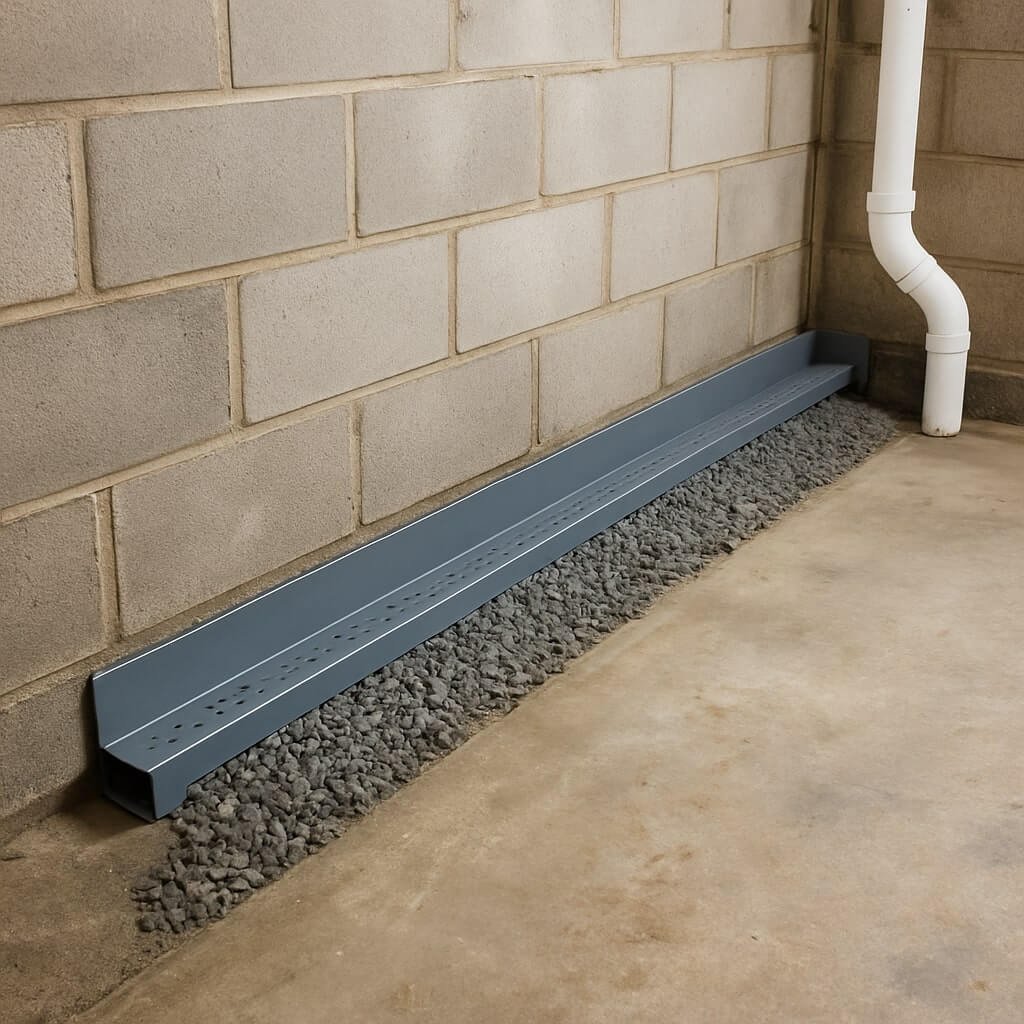If you’re dealing with a damp basement, understanding a basement waterproofing drain channel could be a game changer for your home. This system helps redirect excess water away, preventing moisture and potential flooding. But how does it actually work? Let’s explore the various types of drain channels, their installation process, and the benefits they offer to keep your basement dry and safe. You might be surprised by what you learn next.
Key Takeaways
- A basement waterproofing drain channel captures excess water seeping from walls or floors to prevent flooding and moisture issues.
- It redirects water flow to a sump pump or drainage system, maintaining a dry and safe living environment.
- The system consists of various types, including interior drainage systems like French drains and exterior drainage channels.
- Proper installation involves digging a trench, laying the channel, and ensuring a slope towards the outlet for effective water management.
- Regular maintenance, such as cleaning and inspecting for blockages, is essential for the drain channel’s efficiency and longevity.
Understanding Basement Waterproofing
When it comes to protecting your home from water damage, understanding basement waterproofing is essential. You’ll want to address basement moisture to prevent mold growth and structural issues.
Start by familiarizing yourself with various waterproofing techniques, such as sealing cracks, applying waterproof coatings, and improving drainage systems. Each method plays a vital role in keeping your basement dry.
Regular inspections can help you identify potential leaks early on, allowing you to implement necessary repairs. By taking proactive steps, you can enhance your home’s longevity and maintain a safe, dry living environment.
Don’t underestimate the importance of effective basement waterproofing!
The Function of a Drain Channel
While you may not think about it often, a drain channel plays an essential role in maintaining a dry basement. Its effective design directs water flow away from vital areas, preventing damage and mold growth.
Here’s how it functions:
- Captures excess water: It collects water seeping from walls or floors.
- Redirects water flow: The channel guides water to a sump pump or drainage system.
- Prevents flooding: By managing water, it reduces the risk of basement flooding.
A well-planned drain channel design is important for safeguarding your home from moisture-related issues, ensuring a safe and dry living space.
Types of Basement Drain Channels
There are several types of basement drain channels, each designed to tackle specific drainage needs and conditions.
Interior drainage systems, like French drains, are installed within your basement to collect and redirect water away from the foundation. These are ideal for homes with high groundwater levels.
On the other hand, exterior drainage channels are placed outside your home, helping to direct surface water away from your foundation. They’re great for preventing water from pooling near your basement walls.
Understanding which type suits your situation can greatly enhance your basement’s waterproofing effectiveness and protect your home from water damage.
How Drain Channels Work
Understanding the types of basement drain channels sets the stage for grasping how they operate.
Understanding the various types of basement drain channels is essential for recognizing their operational effectiveness.
These systems rely on smart drain channel design to effectively manage water flow and prevent flooding. Here’s how they work:
- Collecting Water: They capture excess water from walls and floors.
- Directing Flow: The channels guide water toward a sump pump or drainage area.
- Maintaining Dryness: By efficiently moving water away, they help keep your basement dry.
With proper installation, a drain channel can be a reliable solution, ensuring your basement remains a safe and usable space.
Installation Process of a Drain Channel
When you’re ready to install a drain channel, it’s essential to start with a clear plan to guarantee peak performance.
First, gather your drain channel materials, including the channel itself, connectors, and gravel.
Next, mark the installation area, confirming it slopes toward the outlet for ideal drainage.
Dig a trench, taking care to maintain the proper depth.
Then, lay the channel in the trench, connecting segments as needed.
Use gravel to backfill around the channel, and apply installation techniques like leveling and securing with concrete if necessary.
Finally, test your system to verify everything flows smoothly before sealing it up.
Maintenance Tips for Drain Channels
To keep your drain channels working effectively, set up a regular cleaning schedule.
It’s essential to inspect for blockages frequently, as debris can accumulate and cause water to back up.
Regular Cleaning Schedule
Regularly cleaning your drain channels is essential for maintaining a dry and healthy basement.
Establishing a cleaning frequency helps you to catch potential issues early and implement preventative measures.
Here are some tips to keep your drain channels in top condition:
- Clear debris and dirt monthly to prevent buildup.
- Use a wet/dry vacuum or a hose for effective cleaning.
- Inspect the area for any signs of wear or damage.
Inspect for Blockages
Inspecting for blockages in your drain channels is an essential step in maintaining a functional basement waterproofing system. Regular checks can help you identify issues before they escalate. Here are some common blockage causes and effective inspection methods:
| Blockage Causes | Inspection Methods | Solutions |
|---|---|---|
| Leaves and debris | Visual inspection | Clear obstructions |
| Sediment buildup | Water flow test | Flush with water |
| Tree roots | Camera inspection | Professional removal |
Stay proactive by scheduling inspections every few months. Addressing blockages quickly guarantees your drain channels work efficiently, keeping your basement dry.
Benefits of Using a Drain Channel
While many homeowners overlook the importance of proper drainage, using a drain channel in your basement can make a significant difference in preventing water damage.
Many homeowners underestimate proper drainage, but a drain channel in your basement can significantly prevent water damage.
This system enhances drainage efficiency and promotes moisture control, protecting your home from costly repairs.
Here are some key benefits:
- Reduces the risk of mold and mildew growth
- Keeps your basement dry and usable for storage or living space
- Increases your home’s overall value by maintaining structural integrity
Common Problems and Solutions
You might notice water accumulating in your basement despite having a drain channel, leading to mold and mildew growth and potential structural issues.
Understanding these common problems is key to maintaining a dry and safe space.
Let’s explore practical solutions to tackle these challenges effectively.
Water Accumulation Issues
Water accumulation in basements can lead to significant issues, especially if left unaddressed.
You might encounter various problems, from water damage to increased humidity levels. Here are some common issues and practical solutions for moisture prevention:
- Poor drainage systems: Confirm your gutters and downspouts direct water away from the foundation.
- Cracks in walls: Seal cracks with appropriate waterproofing materials to prevent leaks.
- High groundwater levels: Install a sump pump to manage excess water effectively.
Taking these steps can help you maintain a dry basement and protect your home from costly damage.
Don’t wait—act now!
Mold and Mildew Growth
If left unchecked, moisture issues in your basement can quickly lead to mold and mildew growth, creating an unhealthy environment.
To combat this, focus on mold prevention by maintaining proper ventilation and controlling humidity levels. Regularly check for leaks and repair them promptly.
If you discover mildew, act fast; use a mixture of water and vinegar or a commercial mildew remover to tackle the problem.
After cleaning, guarantee the area stays dry to prevent a recurrence.
Structural Integrity Concerns
While addressing moisture issues is essential, neglecting structural integrity concerns in your basement can lead to significant problems over time.
Ensuring foundation stability is vital for maintaining a safe and sound space. Here are some common issues you might face:
- Cracks in walls or floors: These can indicate shifting foundations or excess moisture.
- Leaky pipes: They can contribute to moisture problems and compromise structural integrity.
- Poor drainage: Inadequate moisture control can lead to water pooling, affecting your foundation’s stability.
Choosing the Right System for Your Home
Choosing the right basement waterproofing drain channel for your home can feel overwhelming, especially with the variety of options available. To simplify your system selection, consider these waterproofing options:
| Type | Pros | Cons |
|---|---|---|
| Interior Drain | Easy installation | May require sump pump |
| Exterior Drain | Effective for prevention | More costly |
| French Drain | Great for heavy rain | Possible yard disruption |
Evaluate your home’s specific needs and budget. By understanding each option’s strengths and weaknesses, you can make a more informed decision, ensuring a drier, safer basement.
Conclusion
To summarize, a basement waterproofing drain channel is essential for protecting your home from water damage and mold. By understanding how these systems work and choosing the right type for your needs, you can guarantee a dry and healthy basement. Regular maintenance will keep your drain channel functioning effectively, preventing costly repairs down the line. Don’t wait for water issues to arise—take proactive steps now to safeguard your space and enjoy peace of mind.




